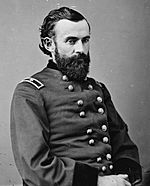6th Wisconsin Infantry Regiment facts for kids
Quick facts for kids 6th Wisconsin Infantry Regiment |
|
|---|---|

|
|
| Active | July 16, 1861 – July 2, 1865 |
| Country | United States |
| Allegiance | Union |
| Branch | Infantry |
| Size | Regiment |
| Engagements | American Civil War |
| Commanders | |
| Colonel | Lysander Cutler |
| Colonel | Edward S. Bragg |
| Colonel | Rufus Dawes |
| Colonel | John Azor Kellogg |
The 6th Wisconsin Infantry Regiment was a group of soldiers who fought for the Union Army during the American Civil War. They were mostly foot soldiers, known as infantry. For most of the war, they were part of the famous Iron Brigade in the Army of the Potomac. This brigade was known for its tough fighting spirit.
Contents
The 6th Wisconsin's Journey in the War
The 6th Wisconsin Regiment was formed in Madison, Wisconsin. Its soldiers officially joined the army on July 16, 1861, agreeing to serve for three years.
They faced tough battles in 1862. They fought bravely at Brawner's Farm during the early part of the Second Battle of Bull Run. Later, in the Maryland Campaign, the 6th Wisconsin attacked Turner's Gap in the Battle of South Mountain. They then suffered many losses fighting against a group called Hood's Texas Brigade at Antietam. This fight took place in a cornfield.
On the first day of the Battle of Gettysburg, July 1, 1863, a leader named Lt. Col. Rufus R. Dawes led a brave counterattack. His soldiers charged against a Confederate group from Mississippi. Many of these enemy soldiers were hiding in an unfinished railroad cut. The 6th Wisconsin forced more than 200 enemy soldiers to surrender. The regiment also fought in the Bristoe and Mine Run Campaigns later that year.
The regiment took part in the Grand Review of the Armies on May 23, 1865. This was a big parade to celebrate the end of the war. The soldiers officially left the army in Louisville, Kentucky, on July 2, 1865.
How Many Soldiers Served and Their Losses
The 6th Wisconsin Infantry started with 1,029 men. Later, 601 more men joined, making a total of 1,630 soldiers who served in the regiment.
Sadly, the regiment lost many soldiers. A total of 16 officers and 228 enlisted men were killed in battle or died later from their injuries. Another 1 officer and 112 enlisted men died from diseases. In total, 357 soldiers from the 6th Wisconsin lost their lives during the war.
Important Leaders of the Regiment

Here are some of the main leaders, called Colonels, who commanded the 6th Wisconsin Infantry:
- Lysander Cutler (May 28, 1861 – November 29, 1862): He was promoted to a higher rank, brigadier general, and even commanded the famous Iron Brigade. He fought through almost the entire war.
- Edward S. Bragg (March 10, 1863 – June 25, 1864): He started the war as a captain. He was also promoted to brigadier general and commanded the Iron Brigade. After the war, he became a U.S. congressman.
- Rufus Dawes (July 5, 1864 – August 9, 1864): He began as a captain and was in charge of the regiment during the Battle of Gettysburg. He left the army after his three years of service. He later became a U.S. congressman and wrote a book about his experiences in the Civil War. His son, Charles G. Dawes, later became the 30th Vice President of the United States.
- John Azor Kellogg (December 10, 1864 – July 14, 1865): He started as a first lieutenant. He was a prisoner of war for several months in 1864. He left the army with the regiment at the end of the war. After the war, he served in the Wisconsin State Senate.
Other Notable People from the 6th Wisconsin
Many other soldiers from the 6th Wisconsin Infantry went on to do important things after the war. Some became politicians, lawyers, or served their communities in other ways.
- Francis A. Deleglise: He was a corporal who was wounded in two battles. After the war, he helped found the town of Antigo, Wisconsin.
- John J. Jenkins: He was a private in the regiment. Later in life, he became a U.S. congressman for seven terms and a federal judge.
- Robert Lees: He was a private who was wounded at Gettysburg. After the war, he became a Wisconsin state senator.
- Francis A. Wallar: He was a corporal and sergeant. He received the Medal of Honor for his brave actions at Gettysburg.
- Jerome Anthony Watrous: He was a private and sergeant. After the war, he became a Wisconsin state legislator and historian. He also served as an army officer in the Spanish–American War.
Images for kids






